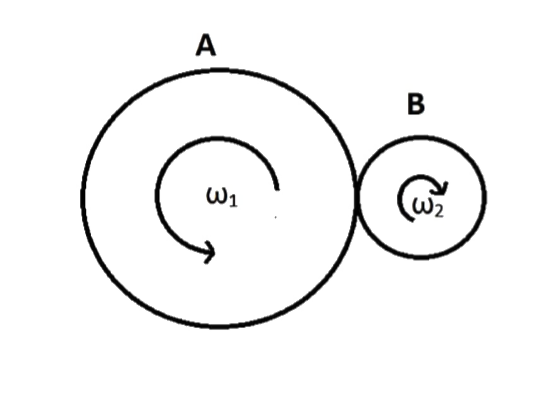Two coaxial discs, having moment of inertia I1 and I12, are rotating with respective angular velocities. ω1 and ω12, about their common axis. They are brought in contact with each other thereafter they rotate with a constant angular velocity. If Ef and Ei are the final and initial total energies, then (Ef−Ei) is:
−I1ω2124
−I1ω2112
38I1ω21
16I1ω21
The correct Answer is:A
From conservation of Angular momentum about the axis:
Li = Lf
⇒I1ω1+I12×ω12=(I1+I12)ωf⇒ωf=54I1ω132I1=56ω1
∴Ef−Ei=12(I1+I12)ω2f−[12I1ω21+12(I12)(ω12)2]=12×3I12(56ω1)2−916I1ω21=I1ω2124
Similar Questions
Two coaxial discs, having moments of inertie I1 and I12 are rotating with respective angular volecities ω1 and ω12, about their common axis.They are brought in contact with each other and thereafter they rotate with a common angular volecity.If Ef and Ei are the final and initial total energies, then (Ef−E1) is:
View SolutionTwo uniform circular rough disc of moment of inertia I1 and I12 are rotating with angular velocity ω1 and ω12 respectively in same direction. Now one disc is placed the other disc co-axially. The change in kinetic energy of the system is :
View Solution
Knowledge Check
Two coaxial discs, having moments of inertia l1andI12 are rotating with respective angular velocities ωandω12 about their common axis. They are brought in contact with each other and thereafter they rotate with a common angular velocity. If EfandEi are the final and initial total energies, then (Ef−Ei) is:
A−I1ω2112BI1ω216C38I1ω21D−I1ω2124Two discs of moments of inertia I1 and I2 about their respective axes , rotating with angular frequencies ω1 and ω2 respectively, are brought into contact face to face with their axes of rotation coincident. The angular frequency of the composite disc will be
Aa. I1ω1+I1ω2I1+I2Bb. I2ω1+I1ω2I1+I2Cc. I1ω1−I2ω2I1−I2Dd. I2ω1−I1ω2I1−I2Two discs of moments of inertia I1 and I2 about their respective axes, rotating with angular frequencies, ω1 and ω2 respectively, are brought into contact face to face with their axes of rotation coincident. The angular frequency of the composite disc will be A.
AI1ω1+I2ω2I1+I2BI2ω1+I1ω2I1+I2CI1ω1+I2ω2I1−I2DI2ω1+I1ω2I1−I2
Two discs A and B are in contact and rotating with angular velocity with angular velocities ω1andω2 respectively as shown. If there is no slipping between the discs, then

View SolutionTwo discs A and B are in contact and rotating with angular velocity with angular velocities ω1andω2 respectively as shown. If there is no slipping between the discs, then

View SolutionTwo discs of moments of inertia I1 and I2 about their respective axes , rotating with angular frequencies ω1 and ω2 respectively, are brought into contact face to face with their axes of rotation coincident. The angular frequency of the composite disc will be
View SolutionTwo uniform circular rough disc of moment of inertia I1 and I12 are rotating with angular velocity ω1 and ω12 respectively in same direction. Now one disc is placed the other disc co-axially. The change in kinetic energy of the system is :
View SolutionTwo bodies having moments of inertia I1andI2(I1>I2) have same angular momentum. If E1andE2 are their rotational kinetic energies,
View Solution
